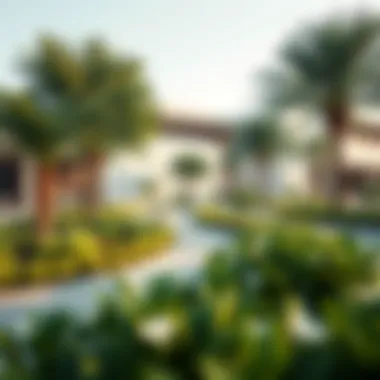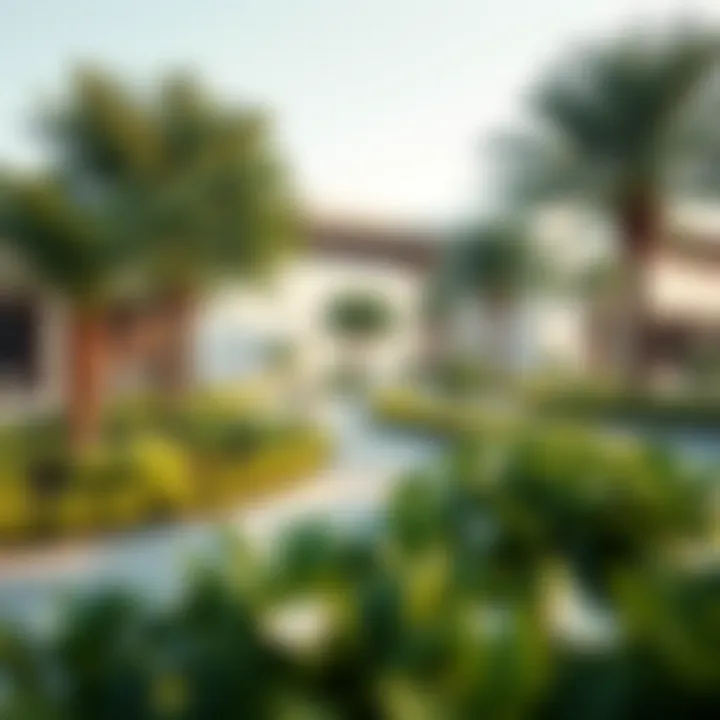A Deep Dive into Al Reem Island's Master Plan


Intro
Al Reem Island stands as a hallmark of urban developement in Abu Dhabi, capturing the imaginations of investors, residents, and developers alike. The master plan for this island is not merely a blueprint; it embodies a bold vision aimed at creating a sustainable, vibrant community that fulfills modern living needs and harness the dynamic spirit of the region. Whether you are an investor eyeing new opportunities, a prospective homeowner, or simply someone interested in urban growth, understanding the intricate layers of this master plan is essential.
The plan outlines a meticulous framework where residential zones meld with commercial ventures, the essence being to cultivate a harmonious lifestyle both for those who live and work there. As urban landscapes evolve, developments like Al Reem Island become essential case studies for the anticipated trends and patterns that will shape future investments and living standards.
Insights about the zoning regulations, environmental considerations, and expected growth in Al Reem Island will illuminate why this area is poised to play a pivotal role in Abu Dhabi's economic landscape. The integration of innovative infrastructure not only supports the existing demographic but also attracts a diverse populace, enhancing the edge of Al Reem Island in a competitive real estate market.
Let’s dive deeper into the compelling components that make up the Al Reem Island master plan, providing a comprehensive overview that resonates with those interested in its far-reaching implications.
Prelude to Al Reem Island
Understanding Al Reem Island is like piecing together a vibrant mosaic of opportunities and challenges that can shape the future of Abu Dhabi. This island is not just a stretch of land; it's a bold claim to urban excellence, offering a unique blend of residential, commercial, and leisure spaces. As we embark on this exploration of the Al Reem Island Master Plan, it’s essential to appreciate what this island represents in terms of investment potential, lifestyle enhancement, and urban development amidst the rapid changes in the UAE.
Geographical Context
Al Reem Island can be found just off the northeastern coast of Abu Dhabi, connected to the Abu Dhabi mainland by a series of bridges. Covering approximately 6.5 square kilometers, it lies in a prime location close to major landmarks, including the city's bustling Corniche and the Central Business District. Its waters are not only a natural feature, but also a regulatory and economic boundary, offering both scenic beauty and strategic significance.
The island is characterized by a mixture of high-rises and lush parks, making it an attractive site for both expats and locals. Additionally, the strategic proximity to other areas such as Saadiyat Island and Yas Island enhances its appeal. The geographical layout allows for stunning waterfront views, ample sunlight, and a well-planned infrastructure, which adds to its value in the real estate market.
Historical Significance
Al Reem Island is relatively young in the context of Abu Dhabi's rich history. Originally, this area was scarcely developed, featuring only a handful of fishing villages dotting its coastline. However, the implementation of the master plan in the late 2000s marked a significant turning point. The vision behind the development was not merely to increase land value but to create a sustainable community with a focus on modern living harmonized with cultural heritage.
As the island progressed through its phases of construction, it became a symbol of the emirate’s ambitions. Developers and government bodies collaborated to overcome initial skepticism regarding the project's scale and scope. Now, each brick laid reflects a commitment to innovation, sustainability, and a blend of tradition with modernity. Its transformation encapsulates a broader narrative of economic diversification and urban planning in the UAE—an evolution fueled by determination and a clear vision for the future.
"The rise of Al Reem Island is a testament to the UAE's commitment to urban excellence and sustainability."
This juxtaposition of historical significance against the backdrop of rapid growth makes Al Reem Island an essential topic for investors, urban planners, and homebuyers alike, providing valuable insights into the region's potential.
Overview of the Master Plan
The Al Reem Island Master Plan stands as a cornerstone of urban development in Abu Dhabi, embracing modernity while honoring sustainability. It’s not just about bricks and mortar; it embodies a vision for a vibrant community where residential life meets commercial success. Understanding the depths of this master plan is crucial for investors, developers, and potential residents, as it outlines the path toward making Al Reem Island a pinnacle of upscale living.
Several key elements form the backbone of the Master Plan:
- Strategic Zoning: The plan categorizes distinct areas for residential, commercial, and mixed-use developments, each tailored to meet specific community needs.
- Infrastructure Development: Emphasis on robust transportation networks and utility services ensures seamless connectivity and convenience.
- Sustainability Initiatives: A commitment to environmental responsibility threads through the plan, focusing on minimizing ecological footprints while promoting green practices.
With these factors in play, the Master Plan is instrumental for:
- Economic Growth: By attracting investment, it lays groundwork for prosperous business ventures and job creation.
- Community Engagement: The design promotes social interactions, encouraging lifestyle amenities that foster a strong sense of belonging.
- Long-Term Viability: A forward-looking approach paves the way for adapting to future challenges and market changes.
Understanding the intricacies of the Master Plan not only prepares stakeholders for the opportunities ahead but also highlights the strategic foresight involved in transforming Al Reem Island into a leading destination.
Vision and Goals
The driving vision behind the Al Reem Island Master Plan is beautifully simple yet profoundly ambitious. It aims to create an integrated environment that enhances the quality of life while stimulating economic activity. The overarching goal is to develop a self-sufficient community that caters to the modern lifestyle of its residents. This means well-planned urban spaces that provide quick access to essential services and recreational areas.
The vision posits Al Reem Island as not just a residential area but as a hub of activity where families thrive and businesses flourish, considering:
- Innovative Architecture: Aesthetic yet functional designs embrace the unique island environment, aimed at creating eye-catching skylines.
- Cultural Connectivity: The inclusion of spaces that celebrate local culture fosters a strong community identity.
In essence, the goals embedded within the vision provide the necessary framework for sustainable growth and community building.
Key Players Involved
The success of the Al Reem Island Master Plan results from the collaborative effort of multiple stakeholders, each playing a pivotal role in its realization. Understanding these key players is crucial for anyone looking to navigate the landscape of development.
- Government Entities: The Abu Dhabi government has a vested interest in the island’s development, ensuring adherence to regulations while enforcing sustainable practices across the project.
- Developers and Investors: Various local and international developers invest capital and expertise, bringing diverse visions to life through residential and commercial projects.
- Real Estate Agencies: Agents not only facilitate sales and rentals but also provide insights into market trends, aiding buyers and sellers alike in making informed decisions.
- Community Organizations: These groups often represent resident interests, ensuring the ongoing discussion about community needs and expectations.
This ensemble of participants lays the groundwork for a dynamic synergy. Each player contributes unique insights and resources, reinforcing the collaborative spirit that underpins the Al Reem Island development.
Zoning and Land Use


Zoning and land use are fundamental aspects that shape the future landscape of Al Reem Island. These regulations dictate how different areas can be utilized, influencing everything from the types of buildings permitted to the density of development. When navigating through the intricacies of real estate investments and development opportunities, understanding zoning becomes indispensable. Not only does it guide developers in compliance with local regulations, but it also ensures that the community thrives in a balanced environment that fosters economic growth while protecting residential spaces.
Residential Areas
Residential zones on Al Reem Island are thoughtfully designed to offer a mix of luxurious living options. High-rise apartments, townhouses, and villas appeal to various demographics, from young professionals to families seeking spacious homes. The layout promotes walkability and accessibility, making it easier for residents to engage with the surrounding community.
Private parks and recreational facilities are embedded within these residential areas, providing a sense of community and enhancing quality of life. For instance, families can enjoy playgrounds while individuals may prefer jogging trails, fostering a sense of belonging. The strategic placement of residential blocks adjacent to commercial areas optimizes convenience for residents, ensuring they have easy access to stores, cafes, and other amenities.
Residents should also consider how zoning impacts property values. Areas with a blend of residential and commercial spaces often experience a boost in demand. This can lead to significant appreciation in property values over time, making Al Reem Island an attractive investment opportunity.
Commercial Districts
The commercial districts in Al Reem Island are designed to cater to a diverse array of businesses, creating an economic engine that supports both local and regional growth. These areas include retail hubs, dining spots, and multinational corporate offices, playing a key role in generating job opportunities.
With zoning regulations that encourage innovative architecture and design, these districts are set to become vibrant centers of activity. Shoppers and diners will enjoy well-planned streetscapes with ample parking and pedestrian-friendly pathways, making it easier to navigate between different outlets.
Furthermore, the strategic zoning allows for flexibility, encouraging mixed-use buildings. This integration of living, working, and leisure spaces enhances the urban experience, drawing residents and visitors alike. The impact on local businesses can’t be overstated; vibrant commercial hubs typically lead to a flourishing local economy, further enticing investors.
Mixed-Use Developments
Mixed-use developments are a cornerstone of the zoning strategy on Al Reem Island. They combine residential, commercial, and office spaces into one cohesive community framework. This type of urban design promotes a seamless lifestyle where residents can live, work, and play within close proximity.
Such developments are valuable for fostering pedestrian traffic and reducing reliance on vehicles, addressing sustainability goals. With shops located on the ground level and residential units above, residents may find daily errands just an elevator ride away. This concept not only adds convenience but also cultivates a lively street atmosphere that can attract more businesses over time.
Moreover, mixed-use developments typically include public spaces, such as parks or plazas, which encourage community engagement and social interaction. This enriches the island's cultural fabric, allowing different demographics to mingle, further enhancing the community spirit.
"Zoning is not just about land use—it's about shaping communities and creating lifestyles that resonate with current and future generations."
In summary, zoning and land use play a pivotal role in shaping Al Reem Island into not just a residential area, but a thriving community. Investors, developers, and residents alike must navigate these regulations thoughtfully to maximize the potential that this master plan holds.
Infrastructure Development
Infrastructure development represents a central pillar of the Al Reem Island master plan. It serves as the framework that enables both residential and commercial growth, shaping the future urban landscape of Abu Dhabi. The effective implementation of infrastructure not only facilitates connectivity but also ensures sustainable living standards and enhanced quality of life for its inhabitants.
The development of robust infrastructure can fundamentally change an area in multiple ways:
- Accessibility: Well-planned transportation networks provide reliable and efficient means for residents to commute. This includes public transport systems, roads, and pedestrian pathways that facilitate mobility across various parts of the island.
- Utilities Integration: Comprehensive utility services, like water, electricity, and telecommunications, are crucial for the prosperity of any community. Without proper utilities, even the most beautifully designed neighborhood can fall flat.
- Economic Growth: Infrastructure facilitates commerce. When businesses can easily access suppliers and customers, it creates a thriving environment for job creation and economic activity.
Given these points, it's clear that investing in infrastructure development is a strategic move that benefits not just the local community but also enhances the island's attractiveness to investors.
Transportation Networks
Transportation networks on Al Reem Island are pivotal to the master plan's success. The aim is to create an interconnected system that supports seamless transit for residents and visitors alike. The inclusion of various modes of transport will cater to diverse needs, including:
- Public Transport: Plans for bus services, and potentially a metro link, aim to minimize vehicular traffic while promoting eco-friendly commuting.
- Walkability: With pedestrian-friendly pathways and cycling lanes, the island fosters a culture of walking and biking, which is healthy, social, and environmentally sustainable.
- Road Infrastructure: Furthermore, the integration of well-maintained roads ensures that both residents and commuters can travel easily through the island.
This comprehensive approach creates a livable environment that can accommodate growth while reducing congestion and pollution.
Utilities and Services
Properly functioning utilities and services are the lifeblood of any thriving community. The Al Reem Island master plan emphasizes the integration of modern utilities to ensure that every resident has access to essential services:
- Water Supply: Advanced water management systems will be implemented, focusing on sustainability and conservation initiatives to minimize waste.
- Electricity: Plans include the use of renewable energy sources, helping to reduce the island’s carbon footprint and support Abu Dhabi’s broader sustainability goals.
- Telecommunications: High-speed internet and effective communication networks are essential attractions for both residents and businesses, promoting a technologically connected lifestyle.
In summary, the infrastructure development of Al Reem Island is meticulously designed to support urban growth, enhance livability, and promote sustainable practices. Each aspect, from transportation to utilities, interconnects to create a cohesive environment that invites investment, nurtures community, and ensures long-term viability.
"Effective infrastructure is not just about roads and buildings; it's about creating an ecosystem that promotes growth and quality of life."
For further reading on urban planning and infrastructure development, visit Wikipedia or check resources on Britannica.
Environmental Considerations
The environmental factors surrounding the Al Reem Island master plan are not just an add-on; they are central to achieving a truly sustainable and harmonious community. In an age where environmental awareness is at a high, understanding how Al Reem Island incorporates ecological elements offers valuable insights to investors, homebuyers, and community planners. Focusing on sustainability and ecosystem preservation not only serves immediate benefits but also addresses long-term impacts that could resonate throughout Abu Dhabi and beyond.


Sustainability Initiatives
Sustainability sits at the heart of Al Reem Island's development strategy. Various initiatives striving to minimize the ecological footprint stem from a careful assessment of land use and resource allocation.
- Green Building Practices: Most of the developments will adhere to stringent green building standards. This means using materials that are sustainable and energy-efficient. Advanced technology solutions, like solar panels and smart grids, are also part of this eco-friendly approach.
- Water Management Solutions: Innovative water recycling systems are proposed to optimize usage. This system emphasizes utilizing greywater for landscaping and other non-potable applications, which can significantly reduce demand on freshwater supply.
- Public Green Spaces: The plan includes the establishment of parks and recreational areas that promote biodiversity. These green belts serve as not only an aesthetic feature but also as a crucial habitat for local wildlife, effectively contributing to the ecological balance.
Ultimately, these sustainability initiatives aim to create a model for urban living that respects and enhances the natural environment, ensuring a livable space for future generations.
Ecosystem Preservation
When it comes to development, preventing the degradation of existing ecosystems is vital. The focus on ecosystem preservation in the Al Reem Island project will safeguard local flora and fauna while enhancing the area's natural beauty.
- Wildlife Corridors: The design incorporates wildlife corridors that allow for the safe movement of animals, effectively preventing habitat fragmentation. This is critical in maintaining species diversity that might otherwise be threatened by urban development.
- Coastal Management: Protecting the marine environment is also an important factor. With its proximity to the Arabian Gulf, particular attention is given to maintaining water quality and protecting coastal and marine habitats. Initiatives may include establishing buffer zones to safeguard coastal zones where marine life thrives.
- Community Involvement: Engaging residents in ecological initiatives is also essential. Programs that promote volunteer clean-up events or tree-planting days can instill a sense of responsibility and connection to the local environment.
"Sustainability is not just a buzzword; it represents a commitment to a healthier planet for generations to come."
For further information on sustainable development practices, you can explore resources like Wikipedia's entry on sustainable development or Britannica's insights on environmental sustainability.
Economic Impacts
The Al Reem Island master plan is more than just a blueprint for development; it represents a substantial shift in the economic landscape of Abu Dhabi. Understanding its economic impacts is crucial for a wide array of stakeholders, including investors, homebuyers, and developers. The vision behind the master plan is crafted not only around residential and commercial aspirations but aims to stimulate economic growth, enhance job opportunities, and promote sustainability across the region.
Investment in Al Reem Island holds potential perks that resonate beyond mere financial returns. This area is forecasted to attract substantial foreign direct investment, providing a lucrative environment for businesses and entrepreneurs. The strategic location and robust infrastructure already set groundwork for commercial activities that could burgeon.
"The economic ramifications of the Al Reem Island development go hand in hand with its ambitious vision, as it endeavors to cultivate a bustling hub of innovation and productivity."
Through this lens, let’s explore the specific aspects of Investment Opportunities and Job Creation and Economic Growth.
Investment Opportunities
The master plan lays out a promising landscape for various types of investments. Given its extensive range of residential and commercial projects, investors can tap into diversified markets. From luxurious high-rise apartments to expansive commercial spaces, Al Reem Island is poised to cater to different demands.
- Real Estate Development: With property values expected to rise, there’s a compelling case for residential real estate investment.
- Commercial Ventures: Retail spaces and office locations are emerging as lucrative investments, catering to a growing population and increasing demand.
- Tourism and Hospitality: The incorporation of recreational facilities and cultural spaces indicates potential growth in tourism, promoting investments in hotels and leisure services.
These opportunities can bring about competitive returns, which makes Al Reem Island a hotspot for investors looking to diversify their portfolios.
Job Creation and Economic Growth
A natural derivative of the investment influx is job creation. As the projects under the master plan come to fruition, companies and businesses will spring up to meet the needs of residents and visitors alike. The subsequent economic growth can spur further development—creating a cycle of opportunity.
- Construction and Development Jobs: Initially, construction jobs will see a significant upswing as projects move forward. This sector alone relies heavily on local labor and can result in thousands of direct and indirect jobs.
- Long-term Employment: Beyond construction, the future residential and commercial spaces promise stable employment opportunities in various sectors, including retail, services, and professional fields.
- Startups and Enterprises: As the island cultivates a vibrant ecosystem, many small businesses and startups might take root, contributing to the dynamic economic fabric of the area.
As these jobs materialize, local professionals and newcomers alike will find abundant prospects, fostering an environment where talent can thrive.
The Al Reem Island master plan is not merely a collection of projects; it represents an economic strategy that shapes the future of Abu Dhabi. The implications of these developments extend far beyond the island itself, as the economical benefits reach into the broader community and contribute to the resilience and growth of the emirate.
Social and Community Development
In the context of the ambitious Al Reem Island master plan, social and community development stands as a cornerstone of the project’s overall success. The integration of vibrant community life within urban planning is essential for fostering a sense of belonging, ensuring social cohesion, and maximizing the benefits for residents and businesses alike. Understanding the dynamics of community as a fundamental element not only enhances the attractiveness of living in such an area but also significantly uplifts the economic potential of Al Reem Island as a whole.
Community Lifestyle and Amenities
Creating a fulfilling community lifestyle in Al Reem Island revolves around ensuring that residents have access to quality amenities. From parks and recreation areas to healthcare facilities and shopping avenues, a careful balance is needed.
- Green Spaces: Imagine walking through neighborhood parks with palm trees swaying gently in the breeze and well-maintained playgrounds echoing with laughter. Green areas promote outdoor activities and serve as gathering spots.
- Community Centers: These centers are the beating heart of any neighborhood, providing a venue for social events, classes, and workshops. A hub of activity where old friendships are formed and new ones blossom.
- Educational Facilities: Access to quality education can’t be overstated. Schools and vocational training centers contribute to a knowledgeable community, preparing future generations for successful careers.
In providing these amenities, Al Reem Island offers an enriched lifestyle that organically nurtures relationships and fosters a sense of community ownership.
Cultural Integration
Cultural integration is yet another vital aspect of social development on Al Reem Island. This community is set to be a melange of cultures, backgrounds, and traditions, and weaving these diverse threads into a cohesive fabric necessitates proactive planning and engagement.
- Cultural Festivals: Hosting festivals that celebrate various cultural heritages not only entertains but also educates. They create opportunities for residents to share traditions, food, and music, fostering understanding and appreciation.
- Civic Engagement: Encouraging residents to participate in civic activities ignites a sense of responsibility and inclusion in community matters. When people feel their voices matter, it strengthens the community bonds.
- Arts and Creativity: Investing in art projects and community spaces dedicated to local artists introduces a creative dimension to the neighborhood. Murals, sculptures, and performance spaces attract visitors and enhance local pride.


In effect, cultural integration on Al Reem Island isn’t purely beneficial for current residents; it positions the island as a vibrant locale for future generations and a compelling destination for investors seeking sustainable growth through community-oriented initiatives.
"A community is not just a place, it’s a spirit that binds its people together."
The overall health of such developments hinges on these two areas—community lifestyle adaptability and cultural integration, which together build a more robust framework for a thriving Al Reem Island.
Future Growth Projections
The concept of future growth projections for Al Reem Island is not just an exercise in optimism; it is a crystal ball into the impending transformation of this area into a top-tier lifestyle and commercial destination. Understanding these projections is crucial for investors, developers, and residents, as they provide insights into how the evolving landscape will affect various facets of life on the island.
Market Trends
Navigating the waters of real estate investment requires a solid grasp of market trends. At the heart of Al Reem Island’s development are factors that signal robust growth potential. Increased interest from expatriates and locals alike is propelling demand for residential units, particularly in light of improved infrastructure and community amenities. Factors to consider include:
- Population Growth: The expanded availability of residential properties is expected to meet the bloating number of inhabitants drawn to a modern lifestyle.
- Economic Diversification: Abu Dhabi's ongoing diversification efforts, aimed at reducing reliance on oil, position Al Reem Island favorably as a commercial hub. Business-friendly policies enhance the attractiveness of investing in commercial real estate.
- Rental Market Dynamics: The island's appeal is shaping a robust rental market, particularly for short-term rentals, catering to tourists and business travelers influenced by upcoming events.
"The trajectory of Al Reem Island is not just a roadmap. It’s a canvas on which the future is painted, with every stroke promising vitality and innovation."
Long-Term Vision
The long-term vision for Al Reem Island encapsulates a holistic approach to urban development. It goes beyond just bricks and mortar to emphasize sustainable living and community integration. Key components defining this vision include:
- Sustainable Living Practices: The island aims to integrate green initiatives extensively, promoting eco-friendly architecture and sustainable materials in all future developments, thereby appealing to environmentally conscious investors.
- Cultural Spaces: There is a strategic focus on fostering cultural and social spaces that bring communities together, seating cultural diversity at the forefront.
- Smart Infrastructure: Incorporating technology into urban design ensures that infrastructure keeps pace with modern needs, reflecting a commitment to developing smart cities. This means efficient transport, enhanced safety measures, and high-quality public services.
In sum, keeping an eye on the future for Al Reem Island suggests a thriving ecosystem for investors, residents, and businesses alike. The projected growth not only offers opportunities but also establishes a commitment to creating a community that is modern, sustainable, and socially vibrant.
Challenges and Considerations
In the realm of real estate development, challenges and considerations inherently shape the trajectory of any grand master plan—Al Reem Island is no exception. The importance of understanding these challenges is paramount for all stakeholders involved. Investors, developers, and even potential residents should be well-acquainted with the regulatory landscape and economic fluctuations that can influence their ventures. This understanding often proves beneficial in making informed decisions that align not just with personal goals, but also with the broader dynamics of the real estate market.
Several critical elements come to light when discussing the challenges surrounding Al Reem Island.
- Regulatory Hurdles: Navigating through the myriad of laws and regulations can often feel like walking through a maze. Local authorities impose zoning laws, building codes, and environmental restrictions that must be adhered to, making it vital for developers to remain compliant to avoid delays or penalties. These regulations are put in place to ensure that the development aligns with the community’s needs and sustainability goals.
- Market Volatility: Economic conditions rarely maintain a steady course. Whether caused by shifts in oil prices, changes in global trade policies, or domestic economic challenges, market volatility poses a substantial risk. Investors and developers must be nimble, reading market trends and adapting their strategies accordingly to mitigate financial risks.
By acknowledging these challenges, stakeholders can better strategize their approaches, paving the way for a more seamless integration into the market.
Regulatory Hurdles
Regulatory challenges remain a significant part of any developmental strategy. The Al Reem Island project involves strict governance, primarily enforced by the Abu Dhabi Urban Planning Council and the Department of Municipalities and Transport. These agencies set forth comprehensive guidelines that dictate the pace and the nature of development. For example, zoning regulations are critical. Each zone has specific uses allocated, whether residential, commercial, or mixed-use. This zoning ensures the development complements existing neighborhoods while adhering to broader urban planning goals.
Additionally, developers often face requirements for environmental assessments. The aim here is to preserve the island's natural beauty and ecological health. Ensuring compliance with these assessments can sometimes slow down progress, but it guarantees that the development is sustainable and livable in the long term. The combined effect of these regulations means developers must invest significant time and resources into their planning phases to avoid costly missteps later in the process.
Market Volatility
The ever-changing nature of the market is another challenge that cannot be ignored. Economic factors at both global and local levels affect buyer sentiment and investment viability. For instance, if oil prices fluctuate dramatically, it may dampen investor confidence, leading to reduced spending and a slowdown in development activities. Investors and developers need to keep their fingers on the pulse of economic indicators, such as employment rates, inflation, and consumer spending.
Moreover, the real estate market's cyclical nature means periods of growth can be followed by downturns. Developers must develop strategies to withstand these fluctuations. Creating a diversified portfolio that spans various real estate types, such as residential, commercial, and retail spaces, can help mitigate risks associated with market volatility.
In understanding the challenges and considerations linked to Al Reem Island, stakeholders can better prepare to navigate the intricate landscape of development, discovering opportunities amidst obstacles.
Ending
The culmination of any comprehensive exploration about the Al Reem Island master plan bears significant weight, especially for those eying the complexities of real estate investment and urban development. Understanding the nuances of this ambitious project not only lays the groundwork for potential financial opportunities but also highlights its implications for the community and environment.
From zoning regulations that dictate land use to the intricate designs of transportation networks, each aspect of the master plan intertwines to create a holistic approach to urban living. Investors, agents, homebuyers, and managers must grasp these elements to make informed decisions.
Benefits and Considerations
- Economic Aspects: The planned developments promise a boost to Abu Dhabi's economy through job creation and enhanced commercial activities.
- Community Integration: Aspects such as cultural integration and community amenities ensure that residents will not merely occupy space but become part of a vibrant and cohesive society.
- Sustainability Efforts: A keen focus on environmental considerations signifies a commitment to the future, maintaining ecological balance while developing a modern lifestyle hub.
In short, the conclusion reflects the transformative potential of Al Reem Island, affirming that this project is not just about constructing buildings; it’s about crafting a way of life that speaks to the heart of Abu Dhabi’s ambitions.
Final Thoughts
In the grand tapestry of urban planning, Al Reem Island stands out as an emblem of forward-thinking development. Investors should see it not merely as a chance to stake a claim but as part of a larger dialogue about urban sustainability and community. Remaining agile in response to market volatility while keeping an eye on regulatory challenges will be key for those looking to engage with this project.
By marrying innovative infrastructure with thoughtful zoning and environmental stewardship, the Al Reem Island master plan is poised to redefine what it means to live and work in this part of the world.
Al Reem Island represents a shift towards a balanced relationship among economic growth, community well-being, and environmental consciousness.
In essence, navigating the intricacies detailed in this overview empowers stakeholders with valuable insights, ensuring they are well-prepared for the evolving landscape of Al Reem Island. For further information, consider exploring resources such as the Abu Dhabi Government or Wikipedia.







